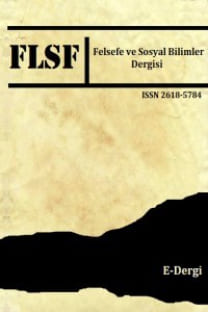İNSAN NEDEN UNUTUR? DÜŞÜNSEL BİR FİGÜR OLARAK UNUTMA SORUNSALI
Unutma, Unutma Biçimleri, Hafıza, Lethe
WHY DOES ONE FORGET? THE PROBLEM OF FORGETTING AS AN INTELLECTUAL FIGURE
Forgetting, Form of forgetting, Memory, Lethe,
___
- Agualusa, José Eduardo. Unutmanın Genel Teorisi. çev. Sevcan Şahin, İstanbul: Timaş Yayınları, 2018.
- Assmann, Aleida. “Formen des Vergessen”, Johannes Gutenberg-Stiftungsprofessur Vorlesungsreihe 2015: Erinnern und Vergessen – Zur Konstruktion von Vergangenheitshorizonten, Mainz: 30.06.2015. URL (18.01.2021): https://www.youtube.com/watch?v=TSsmErEUwEk
- Assmann, Jan. “Das Kulturelles Gedächtnis und das Unbewusste”, in: Michael B. Buchholz, Günter Gödde (Hg.), Das Unbewußte in aktuellen Diskursen. Anschlüsse (Bibliothek der Psychoanalyse; Das Unbewusste 2), S. 368-392, Gießen: Psychosozial-Verlag, 2005.
- Augustinus, St. İtiraflar. çev. Çiğdem Dürüşken, İstanbul: Alfa, 2014.
- Dimbath/Wehling. “Soziologie des Vergessens: Konturen, Themen und Perspektiven”, Oliver Dimbath, Peter Wehling (Hg), Soziologie des Vergessens. Theorie und Methode. Vol. 58, S. 7-36, Konstanz: UVK, 2011.
- Freud, Sigmund. “Erinnern, Wiederholen und Durcharbeiten” Sigm. Freud. Gesammelte Werke X. Werke aus den Jahren 1913-17. S. 125-136. London: Imago Publishing Co., Ltd., 1949. --- “Selbstdarstellung”. Sigm. Freud. Gesammelte Werke XIV. Werke aus den Jahren 1924-31. S. 31-95. London: Imago Publishing Co., Ltd., 1955a.
- --- “Das Unbehagen in der Kultur”. Sigm. Freud. Gesammelte Werke XIV. Werke aus den Jahren 1924-31. S. 419-506. London: Imago Publishing Co., Ltd., 1955b.
- --- “Der Mann Moses und die monotheistische Religion”. Sigm. Freud. Gesammelte Werke XVI. Werke aus den Jahren 1932-39. S. 101-246. Frankfurt am Main: Fischer Verlag, 1961. --- “Das Ich und Das Es”. Sigm. Freud. Gesammelte Werke XIII. Werke aus den Jahren 1920-24. S. 235-289, Frankfurt am Main: Fischer Verlag, 1967.
- Hamilton, Edith. Mitologya. Çev. Ülkü Tamer, İstanbul: Varlık, 2016.
- Korte, Martin. Wir sind Gedächtnis: Wie unsere Erinnerungen bestimmen, wer wir sind. München: Deutsche Verlags-Anstalt, 2017. “Warum Wir vergessen”. Gehirn&Geist. Spektrum der Wissenschaft. S. 42-48, 9/2018.
- Husserl, Edmund. Texte Zur Phänomenologie des inneren Zeitbewusstseins (1893-1917). Hrsg. u. eingel. von Rudolf Bernet. Text nach Husserliana, Band X Hamburg: Meiner,1985.
- Nietzsche, Friedrich. Nachgelassene Fragmante Sommer 1872- Ende 1874. Nietzsche Werke. Kritische Gesamtausgabe III4, hrsg. von Giorgio Colli und Mazzino Montinari, Berlin/New York: De Gruyter, 1978.
- --- Jenseits von Gut und Böse. Zur Genealogie der Moral. Kritische Studienausgabe KSA 5, hrsg. von Giorgio Colli und Mazzino Montinari, Berlin/New York: De Gruyter, 1993.
- --- Tarihin Yaşam İçin Yararı ve Yararsızlığı Üzerine. Çev. Nejat Bozkurt, İstanbul: Say, 2011a.
- --- İyinin ve Kötünün Ötesinde, Bir Gelecek Felsefesini Açış. çev. Ahmet İnam, İstanbul: Say Yayınları, 2011b.
- --- Ahlakın Soykütüğü Üstüne. çev. Ahmet İnam, İstanbul: Say Yayınları, 2013.
- Quiroga, Rodrigo Quian. Borges ve Bellek. çev. Ferit Burak Aydar, İstanbul: Boğaziçi Üniversitesi Yayınevi, 2017.
- Ricoeur, Paul. Yorumların Çatışması. Hermenoytik Üzerine Denemeler I. çev. Hüsamettin Arslan, İstanbul: Paradigma, 2009.
- --- Hafıza, Tarih, Unutuş. çev. M. Emin Özcan, İstanbul: Metis, 2017.
- Varlık, Selami. “Paul Ricoeur’de Bellek ve Kendilik”. Akbank Sanat Felsefe Seminerleri Dizisi: Felsefe ve Bellek. 30.11.2017. URL(08.12.2020): https://www.youtube.com/watch?v=LjSeXzB9jGw
- Weinrich, Harald. Lethe. Kunst und Kritik des Vergessens. München: Beck, 2000.
- Yayın Aralığı: Yılda 2 Sayı
- Başlangıç: 2006
- Yayıncı: Hamdi BRAVO
FREUD VE HEİDEGGER'DE KAYNAĞA DÖNÜŞ TEMASI
ARİSTOTELES’İN FİZİK ESERİNDE DEĞİŞİM KAVRAMI
HÜMANİZMİN SINIRINDA: PICO’NUN “YERSİZ” İNSANINA HEIDEGGER’İN DASEIN’I “YURT” OLABİLİR Mİ?
HOMO EX MACHINA’DAN HOMO EX LABES’E POSTMODERNİST BULANIKLIK
İNSAN NEDEN UNUTUR? DÜŞÜNSEL BİR FİGÜR OLARAK UNUTMA SORUNSALI
AYER’İN EMOTİVİZM’İNDE ETİK İFADELERİN BİLİŞSEL İMKÂNI
ROUSSEAU’NUN SİYASET DÜŞÜNCESİNDE DOĞA DURUMUNUN MODERN DEĞERİ
PLATON’DA YASALAR VE YASALARIN KAYNAĞI
